Mathildenhöhe Darmstadt
By Rachel Heller
What is Mathildenhöhe Darmstadt?
Mathildenhöhe Darmstadt is an artists’ colony founded in 1897 and located in Darmstadt, Germany. The Grand Duke of Hesse set it up as a place for experimentation in architecture, arts, urban planning and landscape design. Various artists designed the buildings that make up the colony and many lived there, using the colony to host international design exhibitions in 1901, 1904, 1908 and 1914.
Today Mathildenhöhe is made up of 23 elements (one of which is a cluster of three houses). The Wedding Tower and the Exhibition Hall are the largest and most prominent of the buildings, but the other elements are just as diverse and interesting, including the Russian Chapel, thirteen houses and art studios, the Plane Tree Grove, and more. The site includes the landscaping as well: the pathways, the artworks in the Plane Tree Grove, and so on.
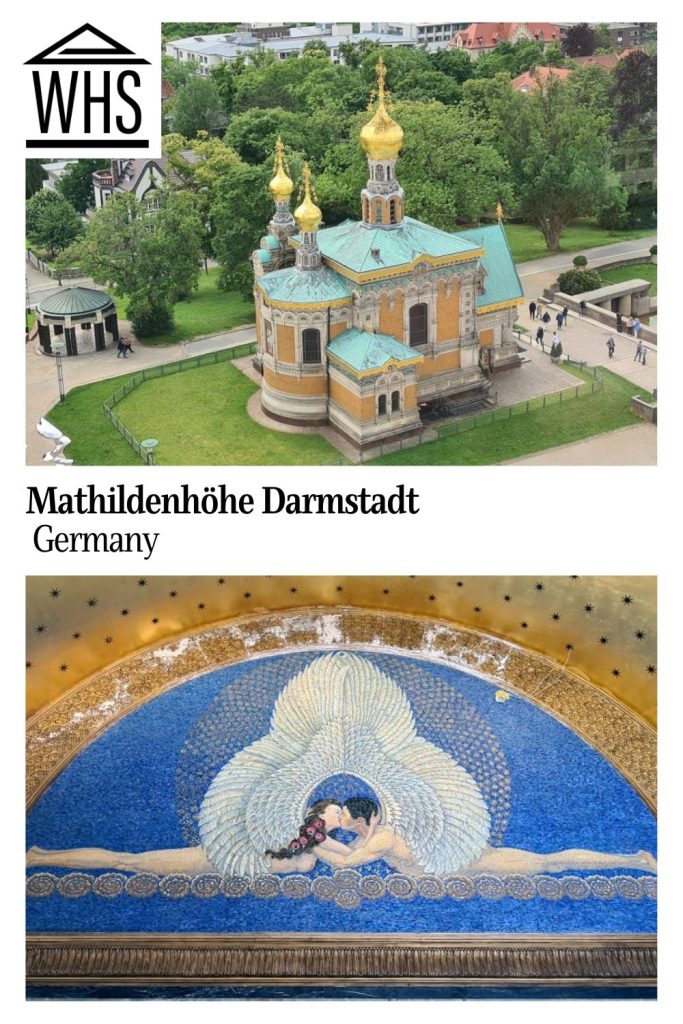
Disclosure: This article contains affiliate links. Making a purchase through an affiliate link will mean a small commission for this website. This will not affect your price. Privacy policy.
Why is Mathildenhöhe Darmstadt a UNESCO World Heritage site?
Mathildenhöhe was groundbreaking in terms of the experiments that were carried out there, particularly in the architecture. UNESCO calls it “a prototype of Modernism that provides compact and exceptional testimony to the emergence of twentieth-century modernist architecture and urban landscape design; and of the avant-garde processes by which this happened.”

In other words, it signaled an important new era in architecture – Modernism – and influenced movements like the Deutscher Werkbund and, later, Bauhaus. The four exhibitions were also a new idea in that the designs on display were permanent, and the artists opened up their own homes and studios as exhibition objects. This was influential on later building exhibitions around the world.
It isn’t on the UNESCO list only because of the architecture. The “designed landscape” in which the experimental architecture stands was also new.
What can you expect on a visit to Mathildenhöhe?
Visitors can freely walk around the area, though only a few of the buildings are open to the public. The architect Joseph Maria Olbrich was the director of the colony and designed 14 of the buildings. Here are the highlights:
The Wedding Tower (1908)
The most immediately eye-catching building is the Wedding Tower (architect: Olbrich), which has a very distinctive shape that UNESCO calls an upraised hand. It reminded me of the Chrysler building in New York City – in other words, art deco – yet it predated art deco by 25 years. Notice the horizontal strip windows; these became a key component of much Modernist architecture in the next couple of decades.
Inside the Wedding Tower is some remarkable and clearly art-nouveau-inspired artwork: mosaics in the lobby and frescoes upstairs in the tower, which is still used as a wedding venue. From the top, you can get a good view over the most prominent of the rest of the buildings: the Russian Chapel, the Exhibition Hall, the Plane Tree Grove, and the Lily Basin. When we visited in the summer, the many trees around the central area obscured most of the individual houses and studios.
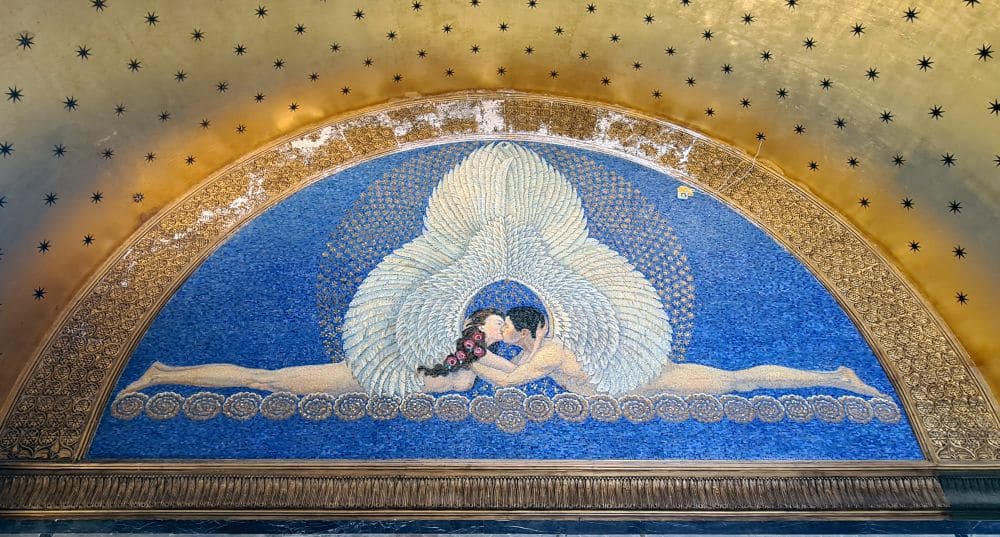
The Russian Chapel of St. Maria Magdalena (1897-99)
This chapel was for Tsar Nicholas II of Russia to use when he and his wife, Alexandra, who came from Darmstadt, visited her family here. Its architect was Leon Benois. It is said that all of the materials that went into making it, including the soil it stands on, were brought over from Russia. You can go inside, but it’s very small so you won’t be able to spend much time there.
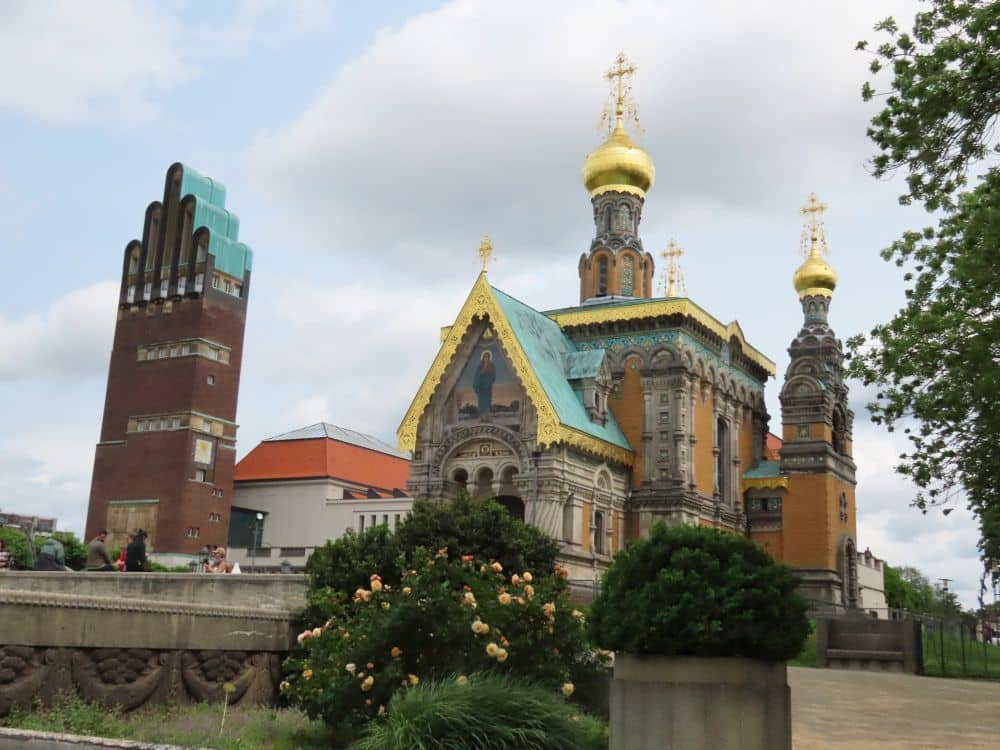
The Exhibition Hall (1908)
Like the Wedding Tower, the Exhibition Hall was designed by Olbrich. While the buildings of Mathildenhöhe were (and are) themselves the permanent exhibits, the Exhibition Hall was used for the temporary displays at each of the four International exhibitions here. It is used for the same purpose today, with rotating temporary exhibitions. See their website to find out what is showing and when.
Ernst Ludwig House (1901)
This house, designed by Olbrich, houses the Artists’ Colony Museum. Inside, for a small fee, you can see the permanent collection of the Mathildenhöhe artists. You’ll see photos and posters from the four exhibitions held here. Most of the space, though, is devoted to examples of the designs produced by the artists who lived here: mostly decorative arts, i.e. furniture, tableware, ceramics and such. The idea was something that is more or less taken for granted today: the interplay of the objects of everyday life and art.
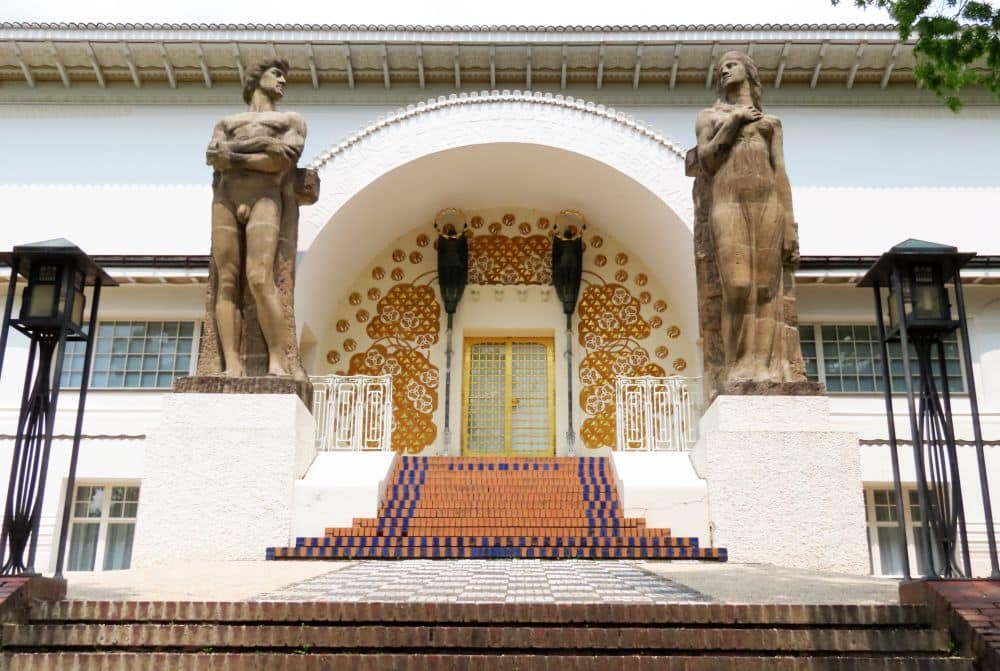
The Plane Tree Grove (1833, 1904-1914)
This grove struck me as looking like a Mediterranean plaza, with a gravel floor and neat rows of plane trees. But wander through it and you’ll see a number of fascinating artworks: bas-reliefs and statues.
Residences and studios
The elements listed above are all on the top of a low hill. The residences and studios are around it, slightly lower, within a block or two. Using the map you can pick up for free at the visitor information booth, take a look at them.
They might, at first glance, seem fairly plain, but Modernist designs are plain. Contemporary architecture today still incorporates many of the simplest elements – horizontal or vertical strips of windows, for example, or rounded corners. And many of these houses and studios have elegant touches that contrast with their plainness. Look at the doors, in particular.
Think about booking a guided tour of Mathildenhöhe Darmstadt or a more specific guided tour of just the Artists’ Colony Museum.
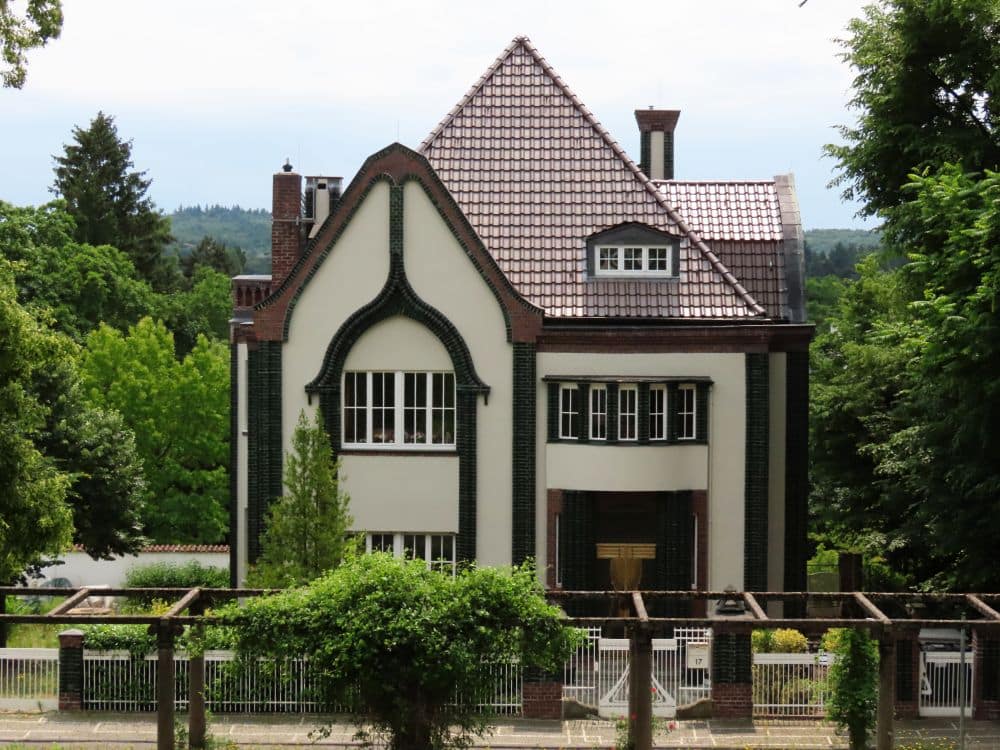
Is Mathildenhöhe Darmstadt worth visiting?
If you’re into architecture, architectural history or the decorative arts, definitely visit this place if you’re anywhere nearby. Besides its importance in terms of architecture and the decorative arts, it’s a pleasant place for a stroll. It’s not particularly child-friendly, though, and I doubt that children would find much of it interesting.
Tips for visiting Mathildenhöhe
If you’re interested in art, especially decorative arts, expect to spend several hours in Mathildenhöhe. It’s not a big place, so walking around to see all the buildings won’t take long: less than an hour. But if you want to read the explanatory signs, find all the outdoor artworks, see the museum well, and go to the top of the Wedding Tower, it’ll take more like three.
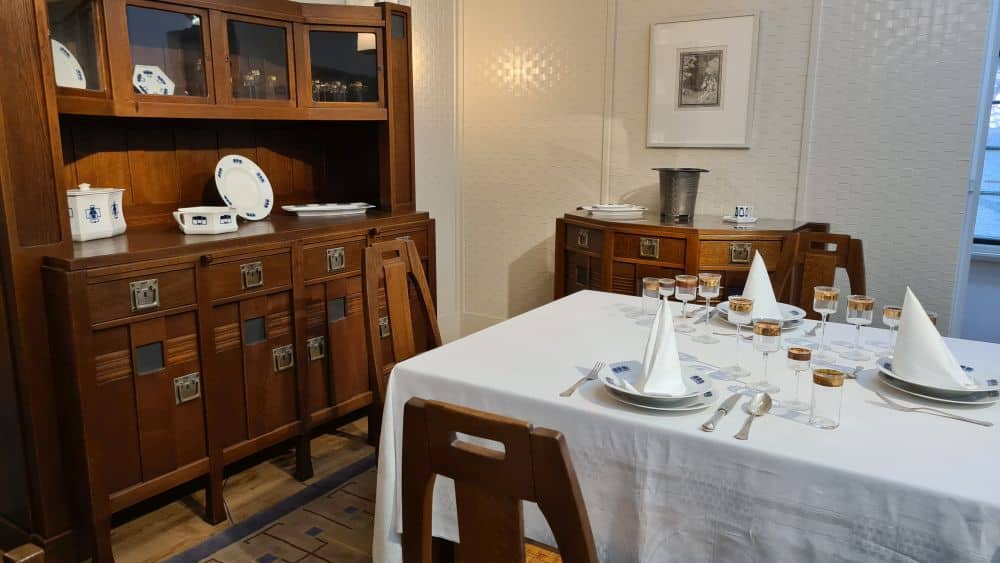
Most of the residences are not open to visitors. People still live and/or work in some of them, so be respectful and don’t trespass on their property.
These are public streets so you can walk around the area any time, but there is a fee for the Wedding Tower, the Exhibition Hall and the Artists’ Colony Museum.
Find accommodations in Darmstadt.
The paths are wheelchair accessible, and the Exhibition Hall, the museum, and the Plane Tree Grove are too. The Wedding Tower is not. It has an elevator inside but the entrance to the building involves a flight of steps.
Other UNESCO sites quite nearby include Messel Pit Fossil Site (fossils from the Eocene), the Abbey and Altenmünster of Lorsch (from the Carolingian period), the Upper Middle Rhine Valley (castles and vineyard scenery), and Bad Ems (part of the Great Spa Towns of Europe UNESCO site).
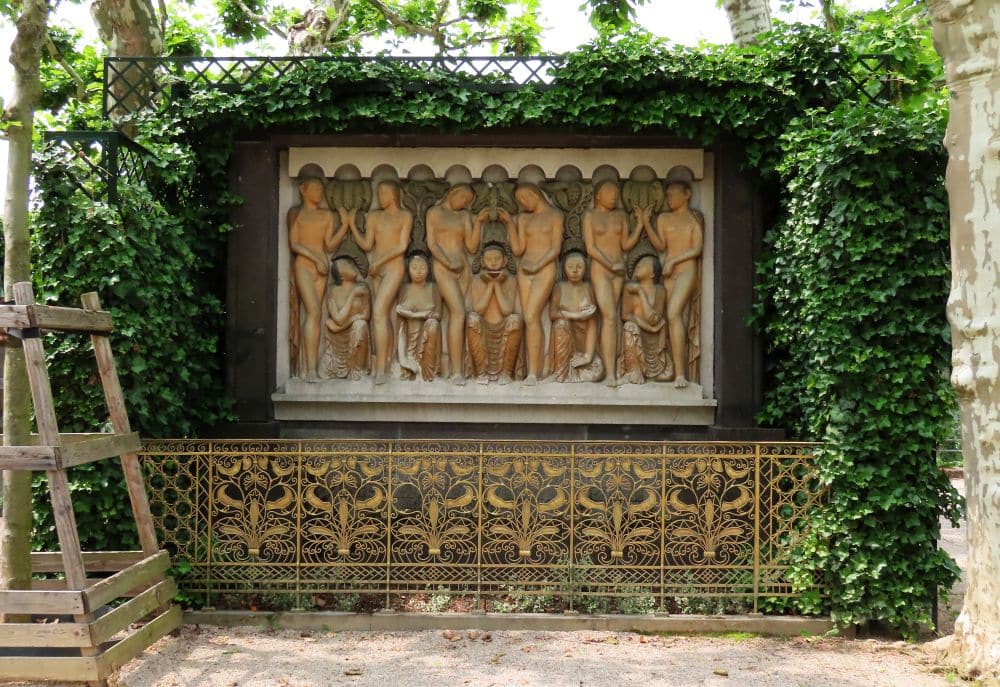
Where is Mathildenhöhe Darmstadt?
Mathildenhöhe is in the city of Darmstadt in the southwestern state of Hesse in Germany.
By car: Assuming no traffic delays, Darmstadt is about a 45-minute drive from the city of Frankfurt, 3 hours from Dusseldorf, or 2.5 hours from Stuttgart. If you’re flying into Frankfurt, the drive is a bit shorter from Frankfurt airport (FRA). That drive will take about a half-hour, if there’s no traffic. The nearest parking is at the Alice Hospital parking garage.
Compare rental car prices here.
By public transportation: From Frankfurt’s main train station, there are direct and frequent trains to Darmstadt’s train station. It’ll take between 16 and 31 minutes, depending on which train you take. From Darmstadt Central Station, take bus F or FM to the Lucasweg/Hochzeitsturm stop or the Putzerstraße/Mathildenhöhe stop.
For more information about Mathildenhöhe Darmstadt, its opening hours and admission fees, see its official website.
Have you been to Mathildenhöhe Darmstadt? If so, do you have any additional information or advice about this UNESCO World Heritage site? Please add your comments below!


Nice overview — clear and engaging. Do any of the houses or studios still host regular exhibitions or artist residencies now, or are most used only for weddings and occasional events? Also, if someone wanted to see the interior mosaics and frescoes, is there a recommended time or guided tour to catch those details?
I think some of the studios do open studios, but the former residences seem to be either residences or offices these days. The museum does do temporary exhibitions, though. Yes, you can see the mosaics and frescos in the Wedding Tower when they’re open, and there are guided tours as well. See the link at the bottom of the article for more information.